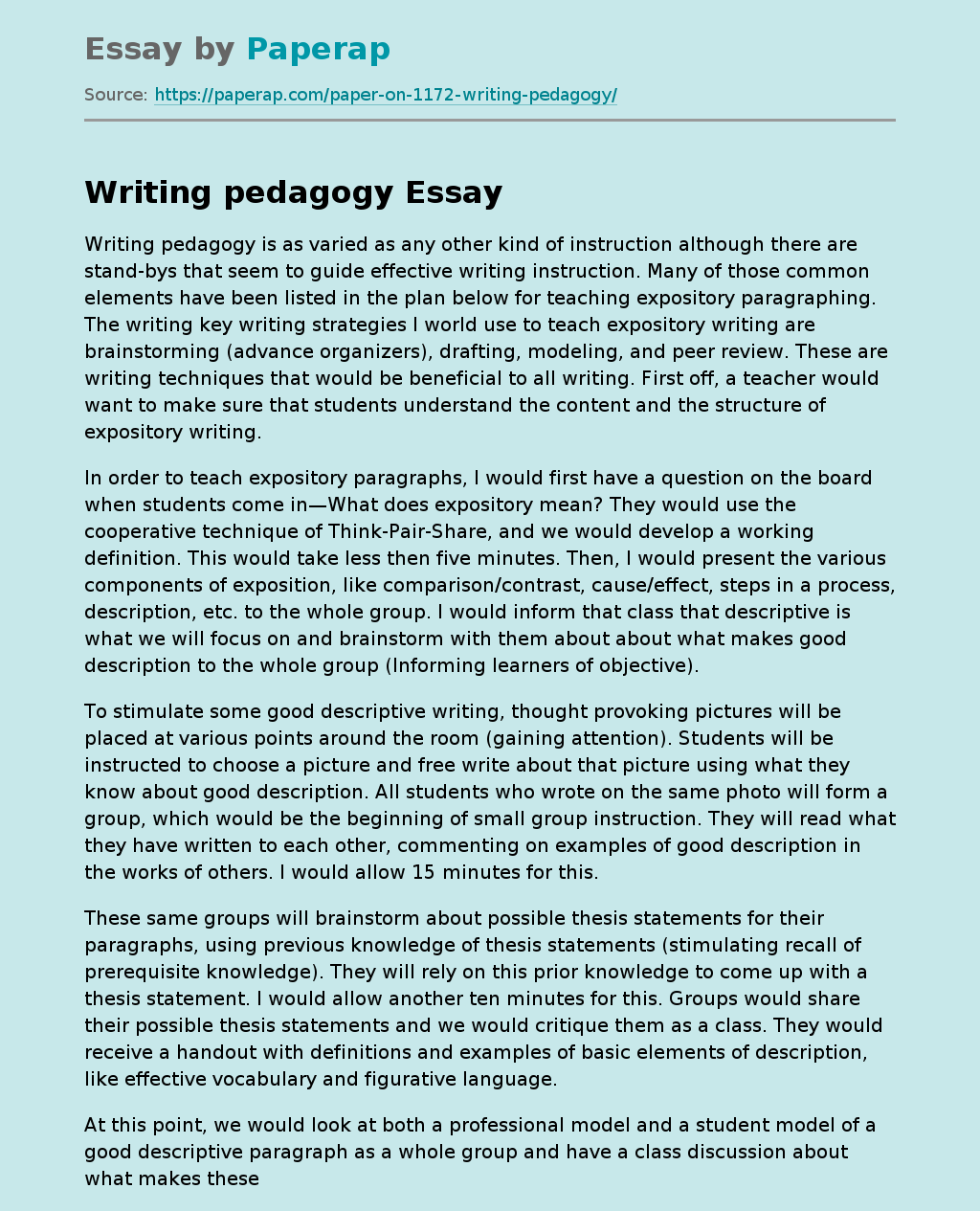Writing pedagogy
Writing pedagogy is as varied as any other kind of instruction although there are stand-bys that seem to guide effective writing instruction. Many of those common elements have been listed in the plan below for teaching expository paragraphing. The writing key writing strategies I world use to teach expository writing are brainstorming (advance organizers), drafting, modeling, and peer review. These are writing techniques that would be beneficial to all writing. First off, a teacher would want to make sure that students understand the content and the structure of expository writing.
In order to teach expository paragraphs, I would first have a question on the board when students come in—What does expository mean? They would use the cooperative technique of Think-Pair-Share, and we would develop a working definition. This would take less then five minutes. Then, I would present the various components of exposition, like comparison/contrast, cause/effect, steps in a process, description, etc. to the whole group. I would inform that class that descriptive is what we will focus on and brainstorm with them about about what makes good description to the whole group (Informing learners of objective).
To stimulate some good descriptive writing, thought provoking pictures will be placed at various points around the room (gaining attention). Students will be instructed to choose a picture and free write about that picture using what they know about good description. All students who wrote on the same photo will form a group, which would be the beginning of small group instruction.
They will read what they have written to each other, commenting on examples of good description in the works of others. I would allow 15 minutes for this.
These same groups will brainstorm about possible thesis statements for their paragraphs, using previous knowledge of thesis statements (stimulating recall of prerequisite knowledge). They will rely on this prior knowledge to come up with a thesis statement. I would allow another ten minutes for this. Groups would share their possible thesis statements and we would critique them as a class. They would receive a handout with definitions and examples of basic elements of description, like effective vocabulary and figurative language.
At this point, we would look at both a professional model and a student model of a good descriptive paragraph as a whole group and have a class discussion about what makes these good and how we would incorporate these methods into our own writing (presenting stimulus material). A rubric will also be provided and explained. This rubric would highlight voice, sentence structure, and various elements of description like use of figurative language, effective verbs, connotation, etc.
Modeling is an essential part of the writing process and one that many teachers miss. Rubrics simply make the end results much more tangible for students rather then just the subjective grade that instructors sometimes give. Students would then draft or revise what they have already written on a computer, including a thesis. They would then email their paragraphs to a partner in the class who would use Word Track Changes to offer helpful suggestions/improvements and email the paragraph back (peer conferences).
Each person would fill out an evaluation form including strengths of the paragraph, suggestions for improvement, areas where more development is needed, and questions for the writer (providing feedback). These will be submitted to the teacher (providing feedback). They would then go so far as to fill out the rubric for their partner’s paper as if they were grading it themselves. When they turn in a final draft, they will write reflectively about their paragraph relating to each point on the rubric and give themselves a grade based on the rubric (providing feedback).
The teacher will then grade these according to the rubric. This lesson or series of activities would provide students with all the essentials of expository writing while hitting on a variety of learning styles and instructional techniques. Expository writing is an important skill for students to have and needs to be taught in a scaffolded approach.
Works Cited
Romano, Tony and Anderson, Gary, Expository Composition: Discovering Your Voice, EMC Publishing, St. Paul, MN, 2008.
Writing pedagogy. (2017, May 24). Retrieved from https://paperap.com/paper-on-1172-writing-pedagogy/

